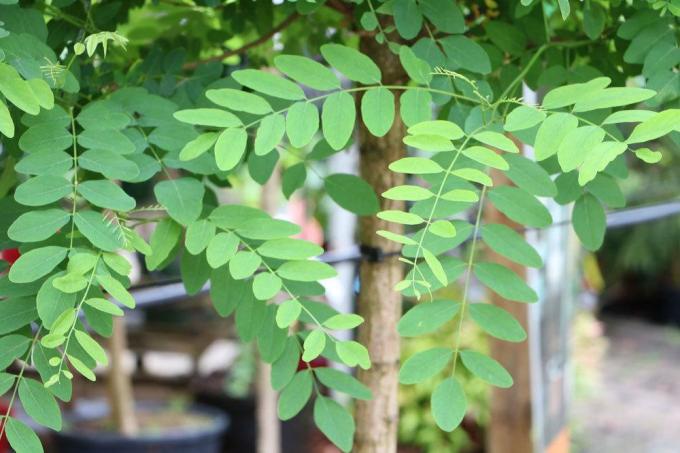
table of contents
- Robinia grows quickly
- Conditions for growth
- The site
- Relatively easy to care for
- Robinia is "self-fertilizing"
- frequently asked Questions
Locust trees are commonly known as avenue trees or from parks. However, they are increasingly finding their way into domestic gardens. After a short time, a stately robinia will grow from a seedling.
In a nutshell
- Robinia are very fast-growing
- almost all parts are poisonous
- Growth depending on the location
- do not make great demands on the care
- Robinia is self-fertilizing
Robinia grows quickly
The black locust (Robinia pseudoacacia), also called Fake acacia or "false acacia" known, grows at quite impressive heights between 20 and 30 meters with a crown diameter of up to 10 meters and more. This tree can be found very often in parks and avenues, and it is also very popular with beekeepers. In forestry it is valued for its very rapid growth. Robinia grows extremely vigorously, especially at a young age. However, it decreases over the years. So the annual increase is:

- 100 to 120 cm in the first 10 years of standing
- from the 10th Year 25 to 50 cm
- from the 40th Year 20 cm
The root system can also take on large dimensions. In a loose substrate it can reach a depth of seven meters and more. The robinia usually forms a taproot. In contrast, in denser soils, the robinia tends to have shallow roots. The entire root system has an extremely firming effect on the soil.
Note: Robinia is a very solid wood with excellent technical properties. The kiln density is 730 kg / m³. Robinia wood is one of the heaviest and hardest woods in Europe.
Conditions for growth
Robinias are hardy and also relatively robust. However, they need optimal conditions in order to grow quickly and healthily. Only then can they reach such impressive heights in a very short time.
The site
The climate and negative environmental influences can have a major impact on how a black locust grows, mainly the growth in height. Please note:
- Location: bright, sunny, sheltered from the wind
- Soil: loose, well ventilated, rich in nutrients, sandy to loamy
- acidic to alkaline pH value no problem
- upgrade very heavy soils with sand or organic compost

Robinia also grows well in a gravel bed, but then relatively slowly. Even a place in the shade does not prevent the tree from growing, but then rather restrained and not so high.
Tip: When replanting in the garden, it should be noted that these trees need a lot of space. Accordingly, sufficient distance from buildings and neighboring properties must be maintained. Information can be obtained from the public order offices of the municipalities and communities.
Relatively easy to care for
Robinia makes very little demands on maintenance when it comes to fertilizing and watering. However, please note:
- fertilize only at a young age
- best time from spring to autumn
- Relatively little water requirement
- insensitive to heat and drought
- Water thoroughly immediately after planting
- keep young trees moist in extreme heat and drought
- no waterlogging
Robinias are hardy, but very sensitive to late and early frosts. Trees that have just been planted should receive additional protection from a layer of mulch or sticks.
Note: The white bergamot-scented blossoms are clustered together and are an excellent pasture for bees. They are very high in sugar. The honey is light to pale yellow and very fluid. It is offered under the name "acacia honey".

Robinia is "self-fertilizing"
As already noted, additional fertilization is only necessary at a young age. With increasing age, robinia are on the one hand able to supply themselves with nutrients from the soil and on the other hand they can absorb nitrogen from the air. This is possible because the so-called legumes live symbiotically with nodule bacteria. With the help of these bacteria, they can bind atmospheric nitrogen. It is then given to the surrounding area. This property proves to be particularly advantageous on low-nitrogen soils.
Note: Robinia are very stubborn, even after they have been felled or cleared, they keep coming back out again.
frequently asked Questions
There are numerous cultivated forms, including smaller ones. These are well suited for keeping bonsai in a bucket. The crown should be thinned out every few years and the roots should be shortened when repotting young specimens. The place must be sunny and sheltered from the wind. Furthermore, every other week has to be watered and fertilized regularly. It is advantageous if bonsai soil is mixed into the substrate.
The seeds and leaves are poisonous and the bark is highly toxic. Only the flowers are not poisonous. Gloves should be worn when handling these plants and a breathing mask when cutting. The plant parts are equally poisonous for humans and animals. The first symptoms such as nausea, vomiting, abdominal pain, palpitations and cramps appear just four hours after consumption. In the worst case, it can lead to death, which is usually fatal for animals.
In advance, it is important to find out about the requirements such as space, floor and maintenance measures. Of course, the choice of the variety also plays a role. When there is little space, cultivated forms are a good alternative. In addition, all official regulations must be checked in order to avoid disputes later. Of course, it must also be borne in mind that the tree is poisonous. So if pets and small children have access to the garden, these trees are rather unsuitable.
